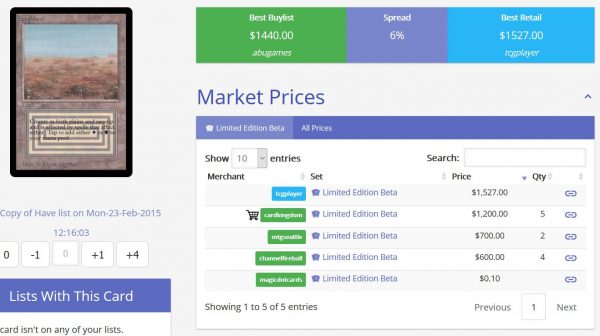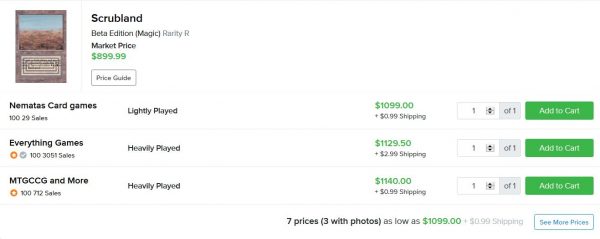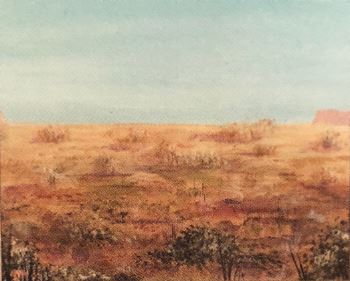Are you a Quiet Speculation member?
If not, now is a perfect time to join up! Our powerful tools, breaking-news analysis, and exclusive Discord channel will make sure you stay up to date and ahead of the curve.
Before jumping into this week’s article, I want to acknowledge a random, yet worthwhile tidbit: this is the 100th article I’ve written for Quiet Speculation since my return to the site a couple years ago. I’ve been writing about Magic for nearly seven years now, and the vast majority of that time was spent with this site. I look forward to the next 100 articles!
This week I want to share some thoughts on a common question I receive across various social media platforms. Whether it be Discord, Twitter, or Facebook, one common question on many folks’ mind is how to price a given Old School card.
You want the price of something new and plentiful, like Mox Amber? Just look it up on TCGplayer or Trader Tools and you will have reliable data.
That’s great when there are hundreds of copies of a card in stock, making the bid/ask spread on the card nearly zero. But this strategy doesn’t work with obscure cards that have limited stock available. So how do I approach pricing these extremely rare and valuable cards? It’s all about using the data available.
Start with Buylists
When I approach pricing of a rare Old School card, I usually want to start by establishing a broad range. From there I seek to narrow that range down as I collect more data. The easiest part of the range to identify is the low end: that should be the top buylist price for the card in question at its respective condition.
Let’s use an example—I just recently picked up a slightly to moderately played Beta Scrubland and am having trouble pricing it. The first place I look is Trader Tools to survey buylists. This data will help me find the floor—the absolute minimum number I should expect to consider when negotiating price. Here’s what I found:

If my Scrubland was near mint, this step of the research would already be complete. But unfortunately my copy is closer to SP- or MP+. So I need to do further research to identify what these shops are paying for played copies. Here’s a quick summary of the numbers from top buylists when accounting for condition.
| Store | Cash Buylist | Trade Credit |
|---|---|---|
| ABU Games | $630 | $950 |
| Card Kingdom | $720 | $936 |
| Channel Fireball * | $625 | $812.50 |
| * Buylist reported incorrectly in Trader Tools |
With this data in hand, I can quickly establish that any number below $720 would be unacceptable. If I wanted to sell this immediately, Card Kingdom’s cash buy price would be the best way to go. Now we know the lowest possible number I should consider when determining this Scrubland’s value.
Upper End of Range
If I want to sell this card to another person, I need to price it higher than buylist. If I wanted to help a fellow Old School player out, of course I could offer at buylist. But I am not desperate to liquidate this card and I have no need to fire-sell it. So my inclination is to aim higher. But how much higher?
To determine this, I next look at how many copies in similar conditions are listed online. The upper end of my range when listing this card for sale needs to be about equal to whatever the cheapest copy is online in the same condition. If I price any higher, then my copy won’t sell until that cheaper copy sells (in a truly rational market).
So let’s see how much one would have to pay for an MP+/SP- Beta Scrubland if they wanted to purchase one right now.
Card Kingdom: Out of Stock
ABU Games: Only NM in stock at $2499.99
Star City Games: Out of Stock
TCGPlayer: LP is $1099.99
eBay: BGS 5.5 listed at $1199.99
Magic Card Market: 1290 Euros
Based on all the above data, I can identify the upper end of my range at $1099.99 because that’s the lowest price someone could pay to purchase a copy of this card immediately. In other words when I list my card for sale, that’s my competition. If I want to have any chance selling my copy, I need to at least beat this price.

Now we have a fairly wide price range: between $720 and $1100. That’s far too wide, so we need to narrow down the range.
Narrowing the Range
Establishing that broad range is strictly data-driven. There’s no subjectivity or finesse associated with the process. Narrowing the range further, however, requires some critical thinking and an evaluation of how eager I am to sell.
For starters, let’s consider the value of avoiding the fees from selling on a platform like eBay. By selling directly to a peer, I avoid 10% in fees right off the bat. Now the upper end of my range is $990. Granted, I could pick something in between $990 and $1100 and split the “savings” with the buyer rather than give the buyer all of the fee savings. But while I’m not desperate to sell, I have opportunities in front of me should I raise enough cash. So let’s say I’m motivated enough to move the card quickly. If I was attached to the card and had less motivation to sell, I may aim higher.
But since I am motivated, I’m willing to give the buyer nearly all the savings from avoiding fees. I’d probably round up and use $1000 as the upper end, giving the buyer a 9% savings versus the cheapest copy on the market.
Next, I’ll look to completed eBay listings to see what people have actually paid lately. I see a copy in similar condition sold at auction recently for $883.50. Kid Icarus also sold a copy a couple weeks ago for $942.

Since these were auctions, I know there are at least a couple buyers willing to purchase this card in the above price range. I have little motivation to sell my copy far below these numbers. That said, if I sold my copy on eBay for, say $900, I’d have to eat a 10% eBay fee and a 2.9% PayPal fee. This would net me about $783. Still, that’s better than the $720 buylist price from Card Kingdom, so I can confidently raise the lower end of my range to $783.
Now my range is tightened to between $780 and $1000.
The Final Touches
I have no motivation to sell the card for below $780 and nobody should feel obligated to pay more than $1000. The space in between? That’s all about the art of negotiation.
There are probably endless books and articles published on this topic, and I don’t claim to be an expert by any means. So I’ll just state the obvious: when offering an Old School card up for sale, start towards the higher end of the range you defined and negotiate downwards. In my case, there’s probably a psychological barrier to that $1000 level so I’ll start with $950. That is a nice round number, a large discount to other copies on the market, and not far above what copies sold for on eBay lately. It seems like a great starting point.
From there, I can entertain offers and accept whatever number I’m comfortable with. That is truly a case-by-case measure. I can’t provide a rule of thumb for everyone to apply—it really depends on the individual. How attached are you to the card? How desperate are you to sell? What’s your opportunity cost for not selling? What is the trajectory for this card’s price over the next three months? Twelve months?
You really need to answer these questions for your particular situation in order to identify that singular value that you should sell a card for. Only you can answer these questions, and therefore only you can identify that number. This is why, when people ask me what a card is worth, I always give a range. I try to do some leg work as outlined above so the range is useful and not lazy; but I can’t provide a single number because I don’t know everyone’s personal situation.
At the end of the day, the individual situation and context is really what determines how much someone is willing to pay, or accept as payment, for that rare, Old School card.
Wrapping It Up
As long as I’m not busy, I’m always happy to help others out when trying to price their Old School cards. It can be difficult when there isn't enough stock online to easily find an accurate number. However, my approach isn’t exactly rocket science. We all have access to the same data, and I generally approach the data the same way every time.
I start with a range driven by available copies on the market and buylist. Then I narrow that range down based on completed listings, fee structures, and motivations to sell. The more eager I am to sell, the lower the price I would accept.
From there, I can’t help you any further. I can only offer a range because the final number depends on factors specific to your situation: your negotiation skills, your eagerness to sell, your opportunity cost, your perception of a card’s long-term potential, etc. Only you can answer all these questions and make the final determination. The lower you go within that range the faster the card will sell.
Hopefully this guide proves useful to everyone. If you have additional data points you use, please feel free to share in the Insider Discord. We can all benefit from learning how to price these obscure cards, especially as the rare get rarer and the expensive get more costly every month. One day—perhaps not even that far in the future—there will be some cards that simply aren’t on the market at all! Pricing such cards will only get more difficult in the future, so the more regimented we can be in our research, the better off we’ll be finding the right price!
…
Sigbits
- While some of the recent Battlebond foil spikes seem speculative at best, one expensive foil that 100% merits its high price is True-Name Nemesis. Card Kingdom is offering $140 for near mint foils. And why not? This is the only foil printing of a Legacy staple. And I doubt a ton of supply is entering the market any more, so this one will stay expensive until it gets another foil reprinting…whenever that will be.
- The buylist at Card Kingdom on Fifth Dawn Engineered Explosives is surprisingly high: $75. At least, it’s surprising to me. I did not realize this card had gotten so expensive. Plus it’s probably tougher to find near mint copies given how much it is played across multiple formats.
- I noticed that Card Kingdom always seems to have a handful of Alpha and Beta cards on their hotlist. Recently they added Alpha Terror, with a $54 buy price. That’s still a hair below ABU Games’ $57.60, but Card Kingdom is starting to get competitive with their numbers on cards that are actually played in Old School.






Cards from Summer Edition often aren’t on the market at all. It can be hard to find NM copies of high end older cards on offer as well.
I would’ve probably ended up at a higher price using the same numbers. I am incredibly patient when it comes to selling. Probably I would’ve priced it at $1050 with a willingness to accept down to $1000. Happy to wait for half a year, maybe even adjust the price upwards if the low copy on TCGplayer sells.
You’re right Summer cards are exceptionally rare and hard to price. For the truly unique, you have to look at data on similar pieces and extrapolate as best you can.
I am less patient and I appreciate cash flow a bit more than most. But I respect your price.
Thanks for sharing!
Sig
I’m guilty of asking you that question. LMAO.
Lol it’s all good! I get it a lot and it is flattering. There’s just no magic to it ;-).